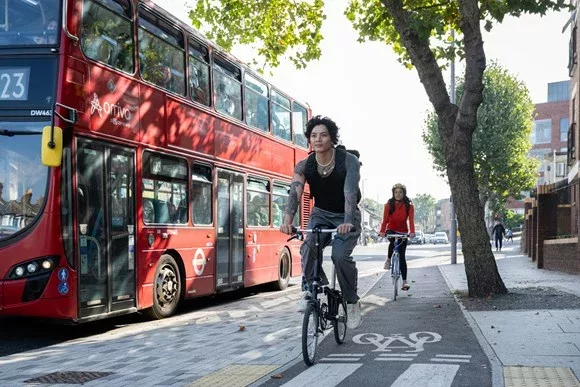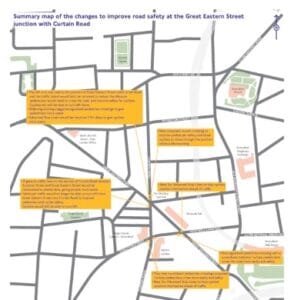Transport for London has published new data from its annual Travel in London report, which shows that there have been continued increases in the levels of walking and cycling in London.
The new data shows that the number of daily cycle journeys increased in 2023 to hit an estimated 1.26 million journeys per day, up by 6.3 per cent from 1.19 million in 2022, and up by 20% since 2019.
TfL says this represents a level of growth not seen in the years leading up to the pandemic and suggests that Londoners are continuing to make the most of cycling as a sustainable and affordable way of travelling around the capital. While central London has seen a smaller level of growth (1.7 per cent) reflecting hybrid working and less commuter cycling, both inner and outer London have seen strong increases of 8.2 per cent and 5.5 per cent respectively compared to 2022 levels. Separate data from the report shows that in the financial year 2022/23, the percentage of all journeys made by cycling reached 4.5 per cent, a significant increase compared to the pre-pandemic level of 3.6 per cent in 2019/20.
New data also shows that the proportion of Londoners who have cycled in the past year has increased, including increases among people from Black, Asian other minority ethnic groups. In the financial year 2022/23, 24 per cent of Londoners reported having cycled in the past year, up from 21 per cent in 2019/20. This includes increases among all ethnic groups, including Black people (12 per cent in 2019/20 to 15 per cent in 2022/23) and Asian people (11 per cent in 2019/20 to 15 per cent in 2022/23). [4] However, in relation to the sociodemographic profile of all London residents there is still under-representation on many of these groups which is why earlier this year, TfL set out its vision for making cycling more representative of London’s diverse communities through its Cycling Action Plan 2. This outlined ambitious evidence-led measures to support underrepresented groups by addressing the barriers they face. This includes investment through the annual Walking and Cycling Grants London programme, with groups awarded funding every year to boost participation among underrepresented groups from a wide range of backgrounds and ages.
Transport for London
Wednesday 6 Dec 2023
New TfL data shows sustained increases in walking and cycling in the capital
New TfL data shows sustained increases in walking and cycling in the capital
Download
PN-144
TfL has published new data from its Travel in London report, which shows trends in travel during 2022 and 2023
The data shows the number of daily cycle journeys increased to 1.26 million in 2023, up by 6.3 per cent since 2022 [1]
24 per cent of Londoners report having cycled in the last year, up from 21 per cent in 2019/20[2]
Investment in London’s cycle network is enabling more people to cycle, with the strategic cycle network now 352km long, up from 90km in 2016
Transport for London (TfL) has published new data from its annual Travel in London report, which shows that there have been continued increases in the levels of walking and cycling in London. Enabling more people to walk and cycle, including as part of journeys that also involve public transport, is vital to a sustainable transport network in the capital and TfL has continued to work closely with London’s boroughs to invest in high-quality infrastructure that allows more people to walk and cycle more often.
The new data shows that the number of daily cycle journeys increased in 2023 to hit an estimated 1.26 million journeys per day, up by 6.3 per cent from 1.19 million in 2022, and up by 20 per cent since 2019. [3] This represents a level of growth not seen in the years leading up to the pandemic and suggests that Londoners are continuing to make the most of cycling as a sustainable and affordable way of travelling around the capital. While central London has seen a smaller level of growth (1.7 per cent) reflecting hybrid working and less commuter cycling, both inner and outer London have seen strong increases of 8.2 per cent and 5.5 per cent respectively compared to 2022 levels. Separate data from the report shows that in the financial year 2022/23, the percentage of all journeys made by cycling reached 4.5 per cent, a significant increase compared to the pre-pandemic level of 3.6 per cent in 2019/20.
New data also shows that the proportion of Londoners who have cycled in the past year has increased, including increases among people from Black, Asian other minority ethnic groups. In the financial year 2022/23, 24 per cent of Londoners reported having cycled in the past year, up from 21 per cent in 2019/20. This includes increases among all ethnic groups, including Black people (12 per cent in 2019/20 to 15 per cent in 2022/23) and Asian people (11 per cent in 2019/20 to 15 per cent in 2022/23). [4] However, in relation to the sociodemographic profile of all London residents there is still under-representation on many of these groups which is why earlier this year, TfL set out its vision for making cycling more representative of London’s diverse communities through its Cycling Action Plan 2. This outlined ambitious evidence-led measures to support underrepresented groups by addressing the barriers they face. This includes investment through the annual Walking and Cycling Grants London programme, with groups awarded funding every year to boost participation among underrepresented groups from a wide range of backgrounds and ages.
Walking also continues to be central to how many people travel in London, with levels increasing in 2022/23. New data from the Travel in London report shows that walking accounts for 39 per cent of all trips by London residents. Overall trip rates have increased from 0.66 trips per person per day on average in 2017/18 to 0.80 in 2019/20 and 0.84 in 2022/23



























